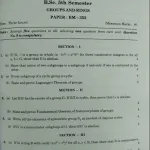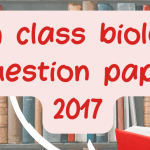KUK old question papers are useful for exam preparation, providing insight into question patterns, topics, and marking schemes. This guide covers questions and answers for various subjects to help students prepare effectively. The following sections contain questions and answers for all subjects to assist in comprehensive understanding and practice.
Question: What are the key elements of an essay?
Answer: The key elements of an essay include an introduction, body paragraphs, and a conclusion. Each part serves a specific purpose in presenting the argument.
Question: Define a metaphor with an example.
Answer: A metaphor is a figure of speech comparing two unrelated things, saying one is the other. Example: “Time is a thief.”
Question: What is the difference between active and passive voice?
Answer: Active voice has the subject performing the action, while passive voice has the subject receiving the action. Example: “She wrote a letter” (active), “A letter was written by her” (passive).
Question: How can one improve vocabulary effectively?
Answer: Regular reading, using flashcards, practicing new words in sentences, and engaging in conversations are effective ways to improve vocabulary.
Question: What is the importance of punctuation in writing?
Answer: Punctuation clarifies meaning, separates ideas, and enhances the readability of a text. Incorrect punctuation can alter the intended meaning.
Question: Define the term ‘alliteration’ with an example.
Answer: Alliteration is the repetition of initial consonant sounds in closely placed words. Example: “She sells seashells by the seashore.”
Question: What is the theme of William Wordsworth’s poem “Daffodils”?
Answer: The theme of “Daffodils” is the beauty of nature and how it brings joy and inspiration to human life.
Question: What is the role of a thesis statement in an essay?
Answer: A thesis statement presents the main idea or argument of an essay, guiding its content and structure.
Question: Differentiate between a simile and a metaphor.
Answer: A simile uses “like” or “as” to compare two things (e.g., “as brave as a lion”), while a metaphor directly equates them (e.g., “He is a lion”).
Question: What is the structure of a formal letter?
Answer: A formal letter includes the sender’s address, date, recipient’s address, salutation, body, closing, and signature.
Question: What are homophones? Provide examples.
Answer: Homophones are words that sound the same but have different meanings and spellings. Examples: “to,” “too,” “two”; “there,” “their,” “they’re.”
Question: Explain the importance of reading comprehension skills.
Answer: Reading comprehension helps understand, analyze, and interpret written text, essential for academic success and effective communication.
Question: What is a clause in English grammar?
Answer: A clause is a group of words containing a subject and a predicate. It can be independent (stand-alone) or dependent (needs support).
Question: Define personification with an example.
Answer: Personification assigns human qualities to non-human things. Example: “The wind whispered through the trees.”
Question: What is the rhyme scheme of a sonnet?
Answer: A sonnet typically follows ABABCDCDEFEFGG (Shakespearean) or ABBAABBACDCDCD (Petrarchan) rhyme schemes.
Question: How can one identify the main idea of a passage?
Answer: To identify the main idea, focus on the title, opening sentence, and repeated concepts within the passage.
Question: What are conjunctions, and why are they important?
Answer: Conjunctions connect words, phrases, or clauses, ensuring smooth sentence flow. Examples: “and,” “but,” “or.”
Question: Explain the difference between direct and indirect speech.
Answer: Direct speech quotes exact words (e.g., She said, “I’m happy”), while indirect speech reports them (e.g., She said she was happy).
Question: What are synonyms and antonyms?
Answer: Synonyms are words with similar meanings (e.g., happy, joyful), and antonyms are words with opposite meanings (e.g., happy, sad).
kuk old question paper: Mathematics
Question: What is the formula for the area of a circle?
Answer: The area of a circle is given by A=πr2A = \pi r^2, where rr is the radius.
Question: Define a prime number.
Answer: A prime number is a number greater than 1 that has no divisors other than 1 and itself.
Question: What is the Pythagorean theorem?
Answer: The Pythagorean theorem states that in a right triangle, a2+b2=c2a^2 + b^2 = c^2, where cc is the hypotenuse.
Question: How do you calculate the slope of a line?
Answer: The slope of a line is calculated as m=y2−y1x2−x1m = \frac{y_2 – y_1}{x_2 – x_1}.
Question: What is the value of π\pi?
Answer: The value of π\pi is approximately 3.14159.
Question: What are parallel lines?
Answer: Parallel lines are lines in the same plane that never intersect, regardless of how far they are extended.
Question: How is the perimeter of a rectangle calculated?
Answer: The perimeter of a rectangle is calculated as 2×(length+breadth)2 \times (\text{length} + \text{breadth}).
Question: What is the quadratic formula?
Answer: The quadratic formula is x=−b±b2−4ac2ax = \frac{-b \pm \sqrt{b^2 – 4ac}}{2a}.
Question: Define an acute angle.
Answer: An acute angle measures less than 90 degrees.
Question: How do you find the median in a data set?
Answer: To find the median, arrange the data in ascending order and identify the middle value. If even, take the average of the two middle values.
Question: What is a polygon?
Answer: A polygon is a closed figure with three or more straight sides. Examples include triangles and rectangles.
Question: Define a rational number.
Answer: A rational number is any number that can be expressed as a fraction pq\frac{p}{q}, where q≠0q \neq 0.
Question: What is the difference between mean and mode?
Answer: The mean is the average of a data set, while the mode is the most frequently occurring value.
Question: How is probability calculated?
Answer: Probability is calculated as P=favorable outcomestotal outcomesP = \frac{\text{favorable outcomes}}{\text{total outcomes}}.
Question: What is the volume of a cylinder?
Answer: The volume of a cylinder is given by V=πr2hV = \pi r^2 h, where rr is the radius and hh is the height.
Question: Define a linear equation.
Answer: A linear equation is an equation that forms a straight line when graphed. Its general form is ax+by+c=0ax + by + c = 0.
Question: What is an arithmetic sequence?
Answer: An arithmetic sequence is a sequence of numbers with a constant difference between consecutive terms.
Question: How is the distance between two points calculated?
Answer: The distance is calculated using (x2−x1)2+(y2−y1)2\sqrt{(x_2 – x_1)^2 + (y_2 – y_1)^2}.
Question: Define the term ‘scalene triangle.’
Answer: A scalene triangle is a triangle with all sides of different lengths.
KUK old question papers are an excellent resource for academic preparation. They provide a comprehensive understanding of exam patterns and help in effective practice. Reviewing these question papers ensures better clarity of concepts, enabling students to excel in their studies. Regular practice with these papers boosts confidence and enhances problem-solving skills.
Latest Posts
- Step-by-step guide to download and apply for jee mains admit card 202
- Comprehensive 2025 government holidays and recruitment details for job seekers
- JEE Mains Admit Card 2025: Your Step-by-Step Guide to Downloading the Hall Ticket
- Everything You Need to Know About 2025 Government Holidays Recruitment
- Comprehensive Guide to rrb d group recruitment 2025 – Eligibility, Vacancies, and Application
- Detailed guide to nps trust recruitment 2025 vacancies, eligibility and apply process
- Comprehensive guide to hpcl recruitment 2025 notification, vacancies, and application process
- ignou bed admission 2025 complete recruitment guide with eligibility and process
- Comprehensive Guide to Indian Army Agniveer Recruitment 2025 Notification and Jobs
- Everything You Must Know About CBSE Board Exams 2025 Changes & New Rules






